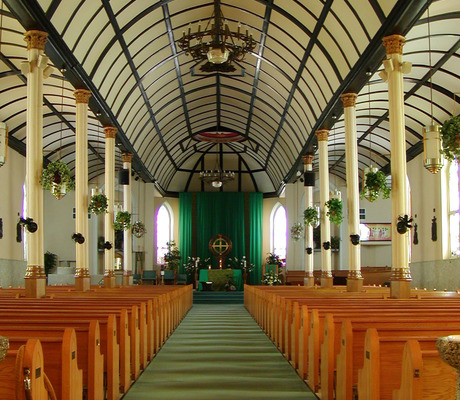
A platform that encourages healthy conversation, spiritual support, growth and fellowship

NOLACatholic Parenting Podcast
A natural progression of our weekly column in the Clarion Herald and blog

The best in Catholic news and inspiration - wherever you are!
Each part of a Catholic church is designed for a different role
-
Pictured above: The nave of St. Peter Claver Church in New Orleans leads to the church's elevated sanctuary. (Clarion Herald file photo by Frank J. Methe)
By BETH DONZE
Clarion Herald
Sanctuary
The sanctuary (derived from the Latin word for “holy place”) is the area around the main altar in which the consecration takes place during Mass and in which the real presence of Christ resides (in the tabernacle) at other times. Sanctuary furnishings include the presidential chair (the chair in which the main celebrant sits); the ambo (from which God’s word is read to the people); and the credence table (which holds the cruets of water and wine, the basin and the finger towel used by the priest during Mass.) Holy oils are kept in a chest or cabinet called an ambry, usually located along a sanctuary wall. The church’s sanctuary lamp burns whenever the Blessed Sacrament is inside the church, as a reminder of Jesus’ real presence in the Eucharist.
Nave
The words “navy” and “nave” are derived from the same Latin word for “ship.” The nave is the part of the church that holds the pews, so you might think of it as the “vessel” inside which you and your fellow congregants are traveling on your earthly journey to heaven.
Sacristy
This part of the church, tucked away from public view, is reserved for the storage and safekeeping of the many sacred items used during the Mass. It is also where the priest vests himself, the altar servers put on their robes and the ushers and other church helpers meet before and after Mass.
Vestibule
Think of the vestibule as your church’s “foyer” – the semi-formal space just inside the entrance doors in which congregants can quietly greet one another and pick up church communications, such as the parish bulletin (or even the Clarion Herald!). Catholic churches typically have a second set of doors leading from the vestibule to the nave. Holy water fonts are placed near this transitional area so people can bless themselves as they move into the more formal and sacred area of the nave.
Choir loft
Older churches often will have a balcony-like feature called a choir loft – the place reserved for the organ, church musicians and singers. The choir loft usually is located above the entrance to the nave, accessible by a set of stairs. In modern times, many choirs and their accompanists have moved much closer to the sanctuary – to the church’s ground floor, off to the side of the altar.
Adoration chapel
This is a sacred room attached to or set aside in a Catholic church for the exposition of the Blessed Sacrament. Chapels offering “perpetual” adoration are available for eucharistic adoration 24/7.
Church shapes
Many Catholic churches are built in the shape of a cross (a “cruciform”) as a reminder of our salvation through Christ’s supreme sacrifice. Some churches built in more recent years were designed as “churches in the round” – an architectural style devised to seat more congregants nearer to the sanctuary.





